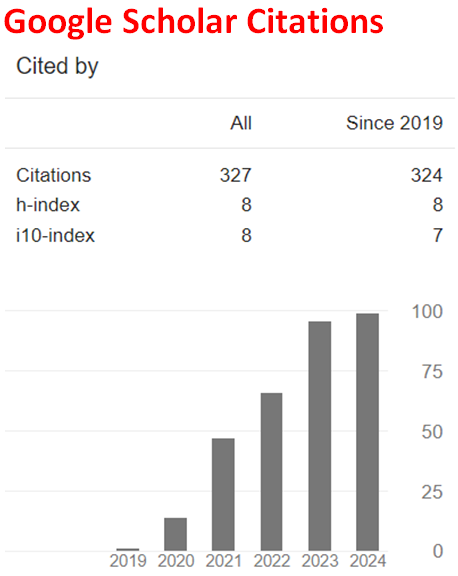Proximate, Minerals and Anti-Nutritional Composition of Water Hyacinth (Eichhornia crassipes) Grass
Abstract
The peels of Eichhornia crassipes were evaluated for its proximate and anti-nutritional composition. The results show that the moisture, ash, crude protein, crude lipid, crude fibre, available carbohydrate and energy value were 89.20 ± 0.23% weight wet, 18.20 ± 0.21 %, 8.2 ± 0.18 %, 2.20 ± 0.03 %, 21.56 ± 0.10 %, 49.98 ± 0.48 % and 252.52 ± 0.50 kcal/100g dry weight respectively. The result of minerals analysis showed that the grass is a good source of both macro and micro elements with calcium as predominant. The result shows that the hydrocyanic acid, nitrate, oxalate and phytate were 0.56 ± 0.01 mg/100gDW, 0.38 ± 0.01 mg/100gDW, 0.33 ± 0.05 mg/100gDW and 4.06 ± 1.69 mg/100gDW. The results indicate that if the grass is properly exploited and processed, they could be a high quality and cheap source of carbohydrates and minerals supplement in the formulation of animal feeds.
References
I. O. Aboaba and A. O. Ketiku, Calcium, magnesium and oxalic acid of some Nigerian foods and beverages, Nigerian Journal of Nutritional Sciences 14 (1993), 45-58.
M. F. Asaolu and S. S. Asaolu, Proximate and mineral composition of cooked and uncooked Solanum melongena, International Journal of Food Sciences and Nutrition 53 (2002), 103-107. https://doi.org/10.1080/09637480220132111
U. Ahmed and U. A. Birnin-Yauri, Comparative analysis of the nutrient composition of cashew (Anacardium occidentale) apple and nut, Nigerian Journal of Basic and Applied Sciences 16(1) (2008), 87-89.
AOAC, Official Methods of Analysis, 15th ed., Washington D.C., USA: Association of Official Analytical Chemists inch. 400-2200 Wilson Boalevard, Arlinton Virginia USA 2 (1990), 910-928.
L. G. Hassan, S. M. Dangoggo, K. J. Umar, I. Saidu and F. A. Folorunsho, Proximate, minerals and anti-nutritional factors of Daniellia oliveri seed kernel, Chemclass J. 5 (2008), 31-36.
IITA, Selected Methods for Soil and Plant Analysis (Manual Series No.1), International Institute for Tropical Agriculture, Ibadan, Nigeria, 1988, pp. 55-56.
W. C. Frazier and D. C. Westhoff, Food Microbiology, 3rd ed., New York: McGraw Hill, 1978.
W. J. Scott, Water relations of food spoilage micro-organisms, Advances in Food Research 7 (1957), 84-127.
C. C. Okaraonye and J. C. Ikewuchi, Nutritional and antinutritional components of Pennisetum purpureum (Schumach), Pakistan Journal of Nutrition 8(1) (2009), 32-34. https://doi.org/10.3923/pjn.2009.32.34
A. F. Waziri, S. A. Anka, A. Y. Bala and H. Shehu, A comparative analysis of nutrients and mineral elements content of Andropogon gayanus Kunth and Pennisetum pedicellatum Trin, Nigerian Journal of Basic and Applied Sciences 21(1) (2013), 60-64. https://doi.org/10.4314/njbas.v21i1.9
J. Kang’ombe, F. Kapute and G. Ntenjera, Nutrient analysis of locally available plant based feed ingredients used by Chingale farmers and their potential for fish feed development in pond raised improved strain of Oreochromis shiranus, ARDEP Dissemination Seminar 2009, Malawi 15-18, 2009.
M. A. Adewolu, Potentials of sweet potato (Ipomoea batatas) leaf meal as dietary ingredient for Tilapia zilli fingerlings, Pakistan Journal of Nutrition 7 (2008), 444-449. https://doi.org/10.3923/pjn.2008.444.449
D. J. Voet, J. G. Voet and C. W. Pratt, Principles of Biochemistry, 3rd ed., New Jersey: John Wiley and Sons, 2008.
A. O. Adesuyi, I. K. Elumm, F. B. Adaramola and A. G. M. Nwokocha, Nutritional and phytochemical screening of Garcinia kola, Advance Journal of Food Science and Technology 4(1) (2012), 9-14.
K. J. Umar, L. G. Hassan, S. M. Dangoggo and M. J. Ladan, Nutritional composition of water spinach (Ipomoea aquatic forsk.) leaves, Journal of Applied Sciences 7(6) (2007), 803-809. https://doi.org/10.3923/jas.2007.803.809
J. D. K. Saka and J. D. Msonthi, Nutritional value of edible fruits of indigenous wild trees in Malawi, Forest Ecology and Management 64 (1994), 245-248. https://doi.org/10.1016/0378-1127(94)90298-4
O. O. Falola, M. C. Alasa, A. J. Amuda and O. J. Babayemi, Nutritional and antinutritional components of Vetiver grass (Chrysopogon zizanioides L. Roberty) at different stages of growth, Pakistan Journal of Nutrition 12(11) (2013), 957-959. https://doi.org/10.3923/pjn.2013.957.959
U. D. Akpabio, L. A. Wilson, A. E. Akpakpan and I. B. Obot, Phytochemical screening and proximate composition of Cassia hirsute seeds, Elixir Appl. Chem. 47 (2012), 8704-8707.
L. G. Hassan, K. J. Umar and Z. Umar, Antinutritive factors in Tribulus terrestris (Linnaeus) leaves and predicted calcium and zinc bioavailability, Journal of Tropical Biosciences 7 (2007), 33-36.

This work is licensed under a Creative Commons Attribution 4.0 International License.


